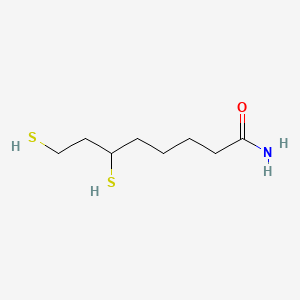| MeSH term | MeSH ID | Detail |
|---|---|---|
| Parkinsonian Disorders | D020734 | 20 associated lipids |
Dihydrolipoamide
Dihydrolipoamide is a lipid of Fatty Acyls (FA) class. Dihydrolipoamide is associated with abnormalities such as Wiskott-Aldrich Syndrome. The involved functions are known as Citric Acid Cycle, Electron Transport, NADH oxidation, Oxidation and Oxidants. Dihydrolipoamide often locates in Mitochondria, Mitochondrial matrix and Chloroplasts. The associated genes with Dihydrolipoamide are Mutant Proteins, Recombinant Proteins, mycothione reductase, Genes, Mitochondrial and alanylproline.
Cross Reference
Introduction
To understand associated biological information of Dihydrolipoamide, we collected biological information of abnormalities, associated pathways, cellular/molecular locations, biological functions, related genes/proteins, lipids and common seen animal/experimental models with organized paragraphs from literatures.
What diseases are associated with Dihydrolipoamide?
Dihydrolipoamide is suspected in and other diseases in descending order of the highest number of associated sentences.
Related references are mostly published in these journals:
| Disease | Cross reference | Weighted score | Related literature |
|---|
Possible diseases from mapped MeSH terms on references
We collected disease MeSH terms mapped to the references associated with Dihydrolipoamide
PubChem Associated disorders and diseases
What pathways are associated with Dihydrolipoamide
There are no associated biomedical information in the current reference collection.
PubChem Biomolecular Interactions and Pathways
Link to PubChem Biomolecular Interactions and PathwaysWhat cellular locations are associated with Dihydrolipoamide?
Visualization in cellular structure
Associated locations are in red color. Not associated locations are in black.
Related references are published most in these journals:
| Location | Cross reference | Weighted score | Related literatures |
|---|
What functions are associated with Dihydrolipoamide?
Related references are published most in these journals:
| Function | Cross reference | Weighted score | Related literatures |
|---|
What lipids are associated with Dihydrolipoamide?
There are no associated biomedical information in the current reference collection.
What genes are associated with Dihydrolipoamide?
Related references are published most in these journals:
| Gene | Cross reference | Weighted score | Related literatures |
|---|
What common seen animal models are associated with Dihydrolipoamide?
There are no associated biomedical information in the current reference collection.
NCBI Entrez Crosslinks
All references with Dihydrolipoamide
Download all related citations| Authors | Title | Published | Journal | PubMed Link |
|---|---|---|---|---|
| Kurakin A | Scale-free flow of life: on the biology, economics, and physics of the cell. | 2009 | Theor Biol Med Model | pmid:19416527 |
| Wu TF et al. | Proteomic investigation of the impact of oxygen on the protein profiles of hyaluronic acid-producing Streptococcus zooepidemicus. | 2009 | Proteomics | pmid:19688725 |
| Xiao Z et al. | Acetoin catabolism and acetylbutanediol formation by Bacillus pumilus in a chemically defined medium. | 2009 | PLoS ONE | pmid:19461961 |
| Günther S et al. | Knockout studies reveal an important role of Plasmodium lipoic acid protein ligase A1 for asexual blood stage parasite survival. | 2009 | PLoS ONE | pmid:19434237 |
| Stern JM et al. | Radiofrequency ablation of small renal cortical tumours in healthy adults: renal function preservation and intermediate oncological outcome. | 2009 | BJU Int. | pmid:19426196 |
| Marino SM and Gladyshev VN | A structure-based approach for detection of thiol oxidoreductases and their catalytic redox-active cysteine residues. | 2009 | PLoS Comput. Biol. | pmid:19424433 |
| Yukumi S et al. | Feasibility of induction heating using a sintered MgFe2O4 needle for minimally invasive breast cancer therapy. | 2008 Jan-Feb | Anticancer Res. | pmid:18383826 |
| Takahashi T et al. | NADPH-dependent coenzyme Q reductase is the main enzyme responsible for the reduction of non-mitochondrial CoQ in cells. | 2008 | Biofactors | pmid:19096101 |
| Gómez-Baena G et al. | Glucose uptake and its effect on gene expression in prochlorococcus. | 2008 | PLoS ONE | pmid:18941506 |
| Min CK et al. | Genome-based construction of the metabolic pathways of Orientia tsutsugamushi and comparative analysis within the Rickettsiales order. | 2008 | Comp. Funct. Genomics | pmid:18528528 |
| Vasquez-Robinet C et al. | Physiological and molecular adaptations to drought in Andean potato genotypes. | 2008 | J. Exp. Bot. | pmid:18535297 |
| Calingasan NY et al. | Influence of mitochondrial enzyme deficiency on adult neurogenesis in mouse models of neurodegenerative diseases. | 2008 | Neuroscience | pmid:18423880 |
| Jiang ZD and Wen YH | [Expressions of c-Fos and NADPH-d in the related brainstem during vestibular compensation]. | 2008 | Zhongguo Yi Xue Ke Xue Yuan Xue Bao | pmid:19180910 |
| Jaleel A et al. | In vivo measurement of synthesis rate of individual skeletal muscle mitochondrial proteins. | 2008 | Am. J. Physiol. Endocrinol. Metab. | pmid:18765679 |
| Norton GJ et al. | Rice-arsenate interactions in hydroponics: whole genome transcriptional analysis. | 2008 | J. Exp. Bot. | pmid:18453530 |
| Vyas PM and Payne RM | TAT opens the door. | 2008 | Mol. Ther. | pmid:18362922 |
| Stensballe A et al. | The amyloplast proteome of potato tuber. | 2008 | FEBS J. | pmid:18331355 |
| Rodrigues DF et al. | Architecture of thermal adaptation in an Exiguobacterium sibiricum strain isolated from 3 million year old permafrost: a genome and transcriptome approach. | 2008 | BMC Genomics | pmid:19019206 |
| Chakraborty S et al. | Characterization of a dihydrolipoyl dehydrogenase having diaphorase activity of Clostridium kluyveri. | 2008 | Biosci. Biotechnol. Biochem. | pmid:18391450 |
| Rapoport M et al. | TAT-mediated delivery of LAD restores pyruvate dehydrogenase complex activity in the mitochondria of patients with LAD deficiency. | 2008 | Mol. Ther. | pmid:18362926 |
